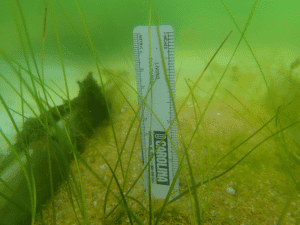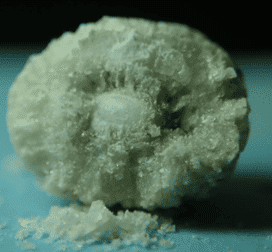by Kirsten Romaguera, UF/IFAS
Seagrasses are vital to the marine ecosystem, where they provide food, habitat, shelter and other services for humans and aquatic organisms. But while seagrass success is threatened by a few factors, including human activities like boating, a crystallized version of human waste could be the answer to revitalizing these marine habitats.
Urine, it turns out, includes two key ingredients in plant fertilizers: phosphorus and nitrogen. Even better, wastewater treatment facilities already process this abundant resource and create byproducts that would otherwise be sent to the landfill.
In its crystallized form, this byproduct is called struvite, the material applied to seagrass in a recent study led by University of Florida scientists.
“Struvite occurs during the wastewater treatment process because magnesium, ammonia and phosphate are all readily available to form the crystal byproduct,” said Conor MacDonnell, who carried out the study as a Ph.D. student in the UF/IFAS department of soil, water, and ecosystem sciences. “The result is a relatively insoluble, sustainable compound found in wastewater treatment plants.”
That relative insolubility led MacDonnell – who earned his degree in 2021 and now works as a UF postdoctoral associate studying seagrass restoration – to team up with Gdańsk University of Technology student Franciszek Bydalek and UF/IFAS faculty members Patrick Inglett and Todd Osborne to investigate whether struvite could be used to fertilize seagrass.
“Coastal ecosystems are dependent upon seagrasses,” Inglett said. “As they diminish, it leads to problems like declining water quality and marine life dying off or migrating to other areas.”
To add to the challenges, current methods of seagrass restoration are relatively expensive and unsuccessful compared to other coastal ecosystems. The study points to nutrient-related issues and competition with algae as reasons behind these difficulties.
In the study, scientists grew three types of plots of seagrass in a simulated setting at the UF Whitney Laboratory for Marine Bioscience. One type received an application of struvite, another received a common controlled-release fertilizer, and the last received no fertilizer. Two experiments were conducted, testing different dosages of fertilizer.
“From the two experiments, we found struvite performed better than the controlled-release fertilizer in seagrass growth,” MacDonnell said. “Struvite seems to provide a slower, more consistent release of nutrients to the seagrass.”
The advantages of using struvite in these efforts, extend into environmental sustainability, researchers say.
“Struvite is potentially a win-win for the environment,” Inglett said. “It is removed from wastewater, so it lessens the impact on downstream ecosystems, and it doesn’t over-fertilize when used for restoration.”
Those downstream effects were investigated in a previous study from another then-Ph.D. student in the same UF department. John Hallas worked with faculty members at the UF/IFAS North Florida Research and Education Center, Cheryl Mackowiak and Ann Wilkie, to research the outputs of water treatment facilities near the Quincy-based center.
“Recovering the struvite from wastewater treatment plants is an effective diversion of these useful nutrients for plant growth, rather than allowing them to enter the landfill,” Mackowiak said.
“It also results in a more useful biosolids product, making the wastewater treatment process more sustainable,” Wilkie added.
MacDonnell explained that struvite’s sourcing also adds to its sustainability credentials over more traditional fertilizers. Mining phosphorus, for example, depletes that finite natural resource and degrades the land.
The potential research on struvite is just beginning, MacDonnell predicts. He has continued studying seagrass restoration and his current role includes working with Osborne as a postdoctoral associate. This work, he says, may include more struvite studies in the future.
“While using struvite in aquatic systems appears very promising, there aren’t many studies of it in marine restoration projects,” he said, “especially in combination with other restoration techniques.”

Photo Credit: Conor MacDonnell.

